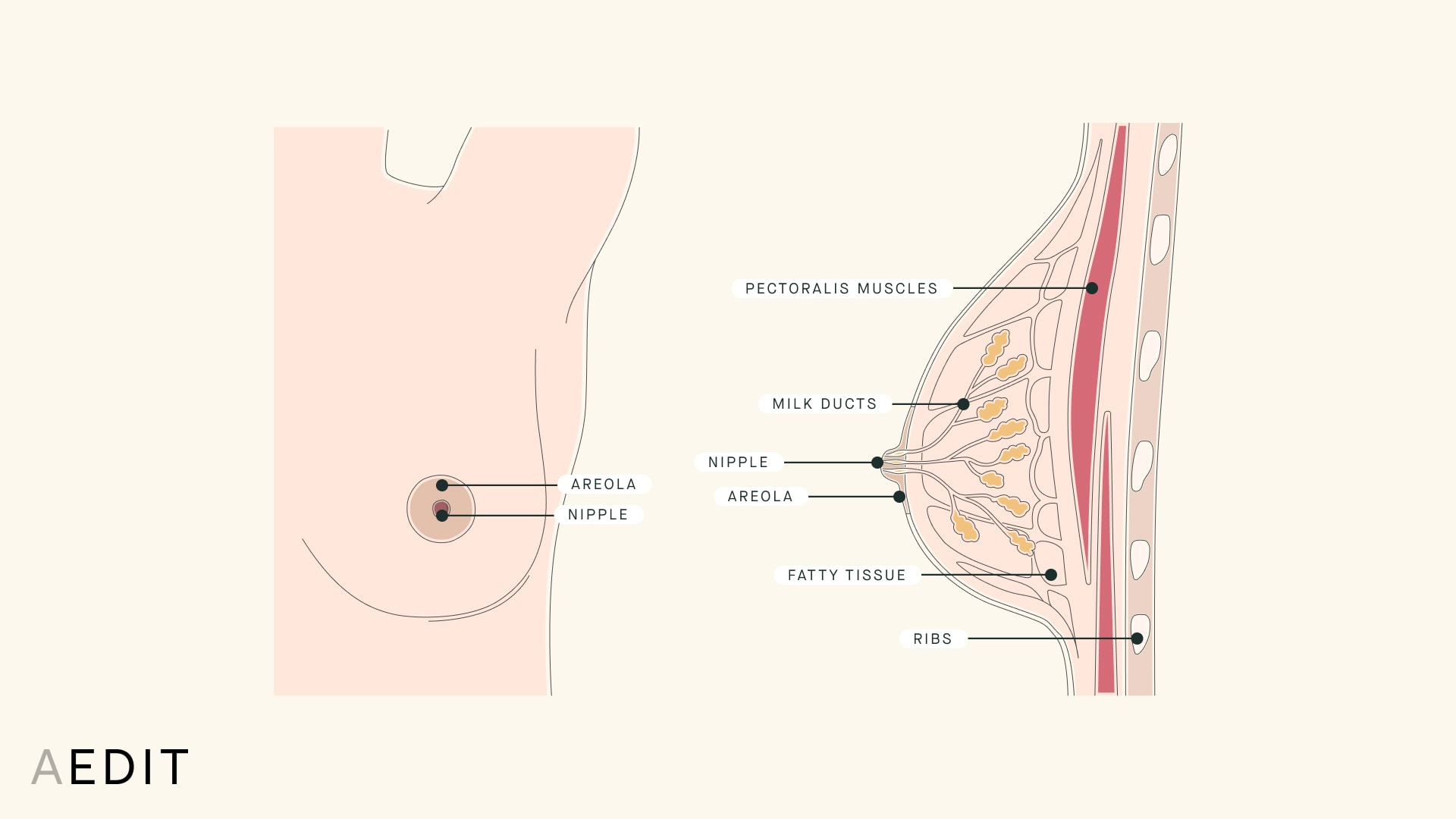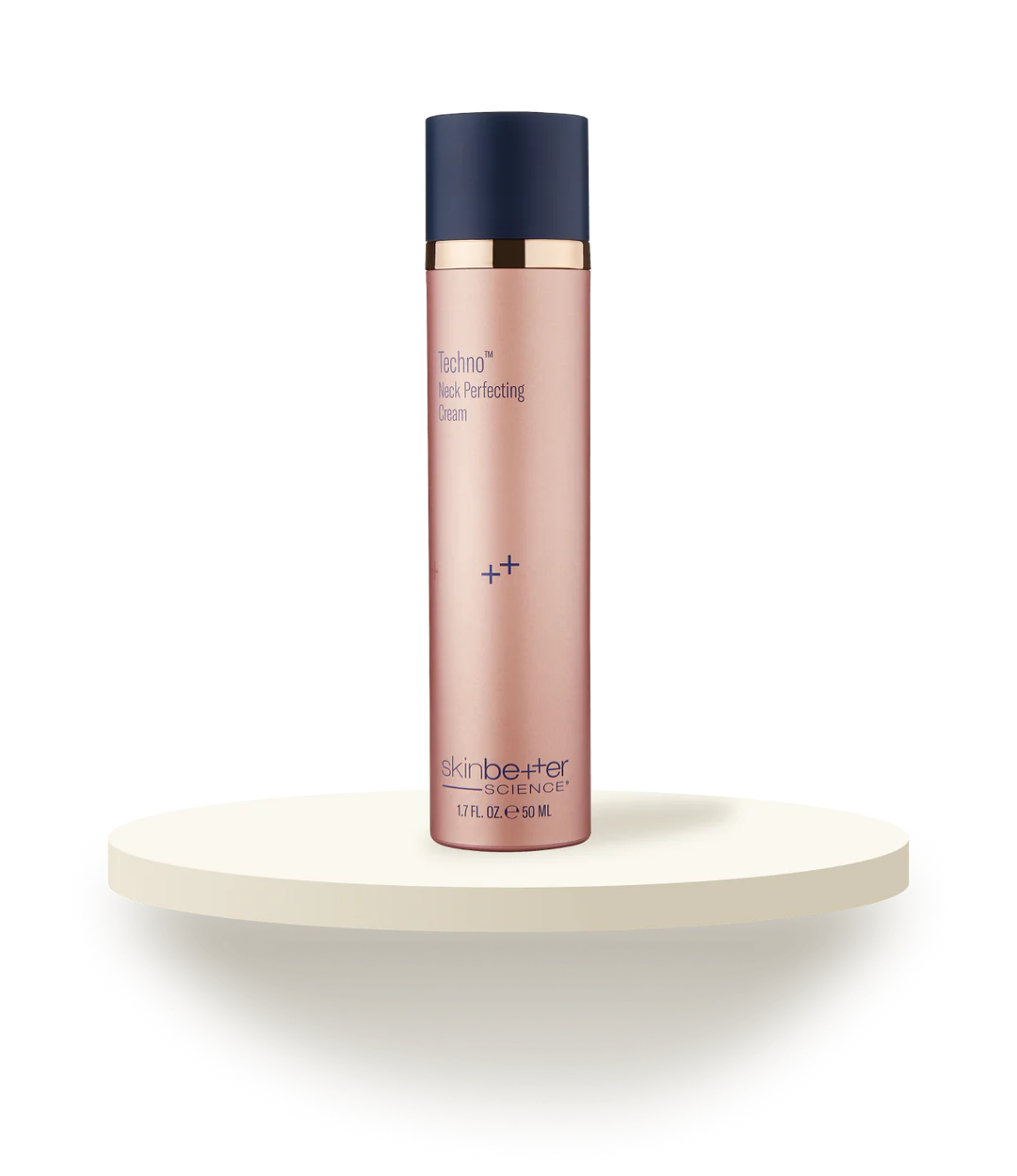What is the function and anatomy of the breasts?
For starters, it's important to understand the anatomy and physiology of the female breast. Unlike men, adult women have teardrop-shaped breasts that contain mammary (i.e. milk-producing) glands and are connected to the pectoral muscle of the chest via ligaments.
Female Breast Anatomy
The external breast includes the skin, nipple, and areola (the hyperpigmented skin surrounding the nipple). The axillary tail, meanwhile, is the breast tissue that connects the breast to the armpit (a.k.a. axilla).
The internal breast is supplied with nerves, blood, and tissue. The connective tissue, for example, provides structure to the breast, while the glandular tissue of the breast contains milk producing cells and ducts that travel toward the nipple and allow for breastfeeding. Those glandular lobes and lobules are, in turn, surrounded by fatty tissue.
It is important to note that the breast is not limited to the breast mound alone. The lymphatic system (i.e. that body's cellular waste management system) extends into the armpit via the tissue in the axillary tail, which is why the area is a consideration when performing breast exams and screening for breast cancer.
What causes variations in breast size and shape?
While women's chests are structurally the same, it goes without saying that no two breasts are the same. The size and shape of the breasts are, first and foremost, determined by genetics. A study of 16,000 women in the journal BMC Medical Genetics found that there are, in fact, seven genetic factors associated with breast size.
With age, the breasts naturally lose their perkiness due to gravity and the natural degradation in the structural tissues. Breasts will sag, nipples begin to tilt downwards, and the areola will start to appear stretched.
Additionally, weight gain and loss will impact breast volume due to increases or decreases in tissue volume. Women who are pregnant experience natural enhancements in breast volume in preparation for breastfeeding, many women find their post-pregnancy and post-breastfeeding breast shape and breast size to be altered from their pre-pregnancy state.
What are the main cosmetic concerns related to the breast?
While the 'ideal' breast size or breast shape is a matter of preference, there are four general cosmetic concerns women may have.
Large Breasts: As a result of genetics or weight, large breasts have the potential to cause both aesthetic and quality of life concerns for women. Large, heavy breasts can lead to neck pain, shoulder pain, and back pain and make ordinary tasks like exercising and even sleeping more arduous.
Small Breasts: More often than not, 'small breasts' are a matter of perception. Women may consider their breasts too small if they are disproportionate to the rest of the body or do not provide the desired curvature or aesthetic.
Sagging Breasts: Aging women and mothers (especially those who breastfed) experience drooping due to the natural breakdown of the supportive breast tissue. Sagging in women with naturally small breasts may not be as noticeable, but all breasts do succumb to gravity over time.
Breast Revision: Revision refers to reversal or refinement of a previous procedure.
Breast implant removal is a common corrective procedure, and women who have experienced a fluctuation in weight or had a child since their original breast procedure may also seek a revision.
For women who have undergone a lumpectomy or mastectomy either preventatively or as part of treatment for breast cancer, breast and nipple reconstruction surgery using implants, fat transfers, or flap procedures is possible. Lean more in our guide to post-mastectomy breast reconstruction.
Who may wish to alter their breast size or shape?
While we can’t control genetics, gravity, or the aging process, continuous advancements in cosmetic surgery allows women to create their ideal breasts. Women who believe their breasts to be too large or too small, moms looking to restore their breasts to their pre-pregnancy appearance, and older women wishing to rejuvenate their youthful, perky breast appearance can benefit from a cosmetic breast surgery procedure. For patients who have already undergone a cosmetic breast procedure but wish to refine the results, revision surgery is also possible.
How can someone change the size or shape of their breasts?
Whether women are looking to make their breasts bigger or smaller, correct sagging, or revise a previous procedure, there is an array of cosmetic breast surgery to improve the appearance of the chest.
You can also check out our complete guides to Breast Augmentation Solutions, Breast Reduction Solutions, and Breast Lift Solutions.
For Small Breasts:
The most common cosmetic surgery procedure performed in the U.S. in 2018 according to the American Society of Plastic Surgeons, augmentation mammaplasty (a.k.a. breast augmentation) can address both size and shape concerns for women who wish to make their breasts bigger. Breast augmentation can be performed with implants, autologous fat transfer, or a combination of the two.
For Large Breasts:
Patients with large breasts that lead to either aesthetic or medical concerns (think: back pain, neck pain, etc.) can reduce the size of their breasts with a reduction mammaplasty (a.k.a. breast reduction). The procedure typically involves creating incisions around the breast to remove excess tissue, which decreases the overall size of the breast and further defines the shape.
For Sagging Breasts:
For patients who experience a loss of elasticity as a result of gravity, age, pregnancy, breastfeeding, or weight changes, a mastopexy (i.e. breast lift) can help to balance uneven breasts, correct stretched areola and drooping nipples, and address the overall projection and contour of the chest. In addition to the wide variety of surgical breast lift techniques, radiofrequency-assisted breast lift procedures can be used to stimulate collagen production and tighten breast tissue in patients dealing with minor sagging who wish to avoid surgery.
For Breast Revision:
While most cosmetic breast surgeries are permanent, lifestyle changes like pregnancy, breastfeeding, and weight gain can all impact the appearance of the results leading women to seek a revision procedure. The American Society of Plastic Surgeons reports that there were nearly 30,000 breast implant removals in the U.S. in 2018, and breast lifts, autologous fat transfers, and breast reductions can also be used to correct or refine existing work.






